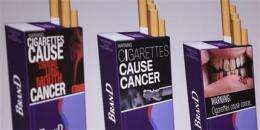Three examples of proposed warning graphics that will appear on cigarette packaging as part of the government's new tobacco prevention efforts, seen in Washington, Wednesday, Nov. 10, 2010. (AP Photo/Evan Vucci)
(AP) -- Corpses, cancer patients and diseased lungs: These are some of the images the federal government plans for larger, graphic warning labels that will take up half of each cigarette package.
The images are part of a new campaign announced by the Food and Drug Administration and the Department of Health and Human Services on Wednesday to reduce tobacco use, which is responsible for about 443,000 deaths per year.
"It acts as a very public billboard because you all of the sudden are reading something about lung cancer from that pack behind the cash register, whereas before you were just reading 'Marlboro,' " said David Hammond, a health behavior researcher at the University of Waterloo in Canada, who is working with the firm designing the labels with for the FDA.
The share of Americans who smoke has fallen dramatically since 1970 from nearly 40 percent to about 20 percent, but those declines have stalled recently. At the same time, the average cost per pack has gone from 38 cents to $5.33.
About 46 million adults in the U.S. smoke cigarettes, and so do with 19.5 percent of high school students.
The new prevention plan is part of the law passed in June 2009 giving the FDA authority to regulate tobacco, including marketing and labeling guidelines, banning certain products and limiting nicotine. The law doesn't let the FDA ban nicotine or tobacco entirely.
"Today, FDA takes a crucial step toward reducing the tremendous toll of illness and death caused by tobacco use by proposing to dramatically change how cigarette packages and advertising look in this country," FDA Commissioner Margaret Hamburg said in a news release. "The health consequences of smoking will be obvious every time someone picks up a pack of cigarettes."
The FDA is proposing 36 labels for public comment, which include phrases like "smoking can kill you" and "cigarettes cause cancer," but also feature graphic images to convey the dangers of tobacco use.
The agency will select the final labels in June after reviews of scientific literature, public comments, and results from an 18,000-person study. Cigarette makers will then have 15 months to start using the new labels.
The new warning labels are to take up half of a pack - both front and back - of cigarettes and contain "color graphics depicting the negative health consequences." Warning labels also must constitute 20 percent of advertisements.
In recent years, more than 30 countries or jurisdictions have introduced labels similar to those proposed by the FDA. The U.S. first mandated the use of warning labels stating "cigarettes may be hazardous to your health" in 1965.
While it is impossible to say how many people quit because of the labels that have been introduced, Hammond said every source of evidence suggests that the labels do spur people to quit.
Meanwhile, Reynolds American Inc., parent company of the nation's second-largest cigarette maker, R.J. Reynolds, is reviewing the labeling plan. But spokesman David Howard said the legality of the new labels is part of the lawsuit filed by the company, Lorillard Inc. and others pending in federal appeals court.
The tobacco makers in the suit had argued the warnings would relegate the companies' brands to the bottom half of the cigarette packaging, making it "difficult, if not impossible, to see."
Anti-tobacco advocates are applauding the federal campaign and the new warning labels.
"This is going to stop kids from starting to smoke ... and it's going to give smokers a strong incentive to quit smoking," said Patrick Reynolds, the grandson of R.J. Reynolds and executive director of the Foundation for a Smokefree America. Reynolds' father, brother and other relatives died from smoking-related illnesses.
It remains to be seen how well the scare tactics will work.
"I don't think they're going to be a deterrent at all for people who already smoke. Most people start smoking when they're young, and I don't think they're going to think about the effects," said 27-year-old Zak Hoffman, who has been smoking since age 14.
More information: Proposed Warning Labels: http://bit.ly/cQwvVc
©2010 The Associated Press. All rights reserved. This material may not be published, broadcast, rewritten or redistributed.



















